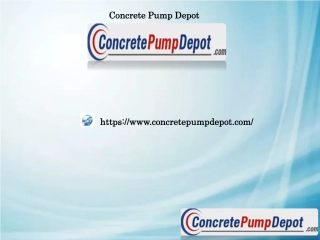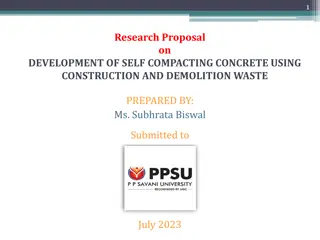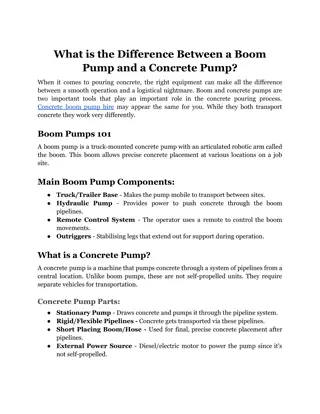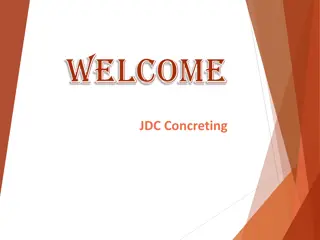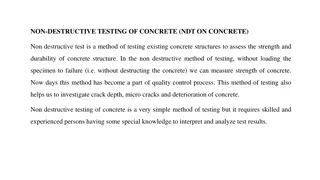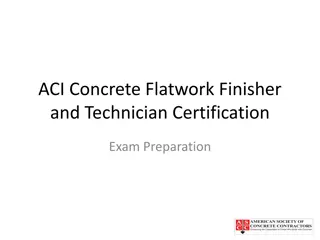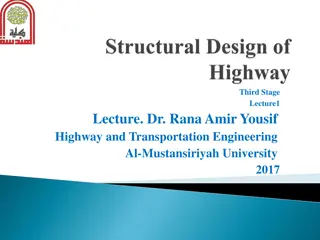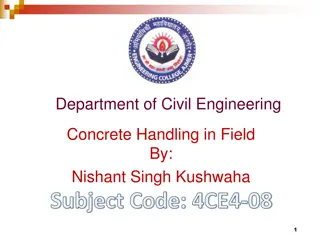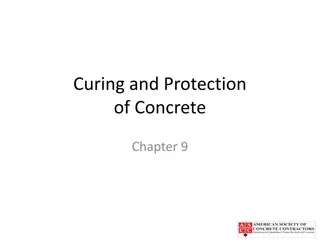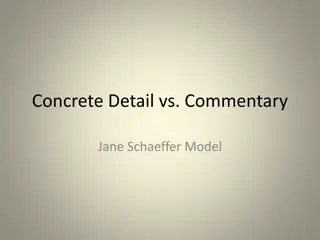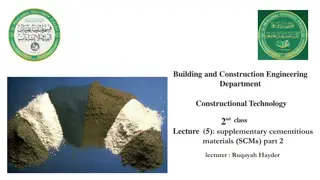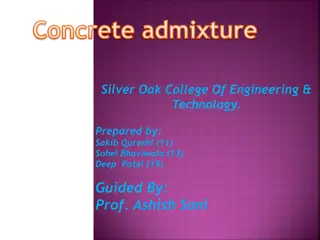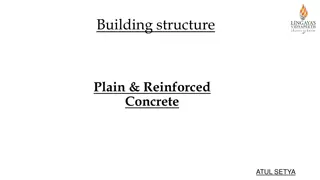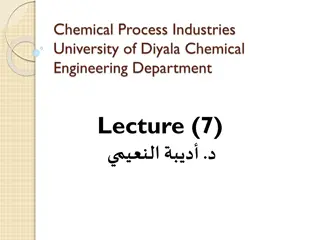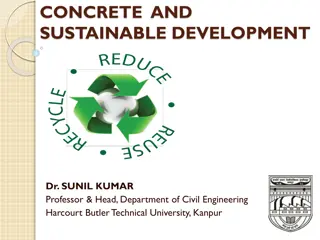Understanding Concrete: Types, Uses, and Classification
Concrete is a composite material composed of binding materials, water, and inert particles. It is classified based on binding materials, design, and purpose. Cement concrete is widely used in construction for its strength and durability, while lime concrete offers an economical alternative where cement is not readily available. Proper placement and curing are crucial for the quality of concrete structures.
Download Presentation

Please find below an Image/Link to download the presentation.
The content on the website is provided AS IS for your information and personal use only. It may not be sold, licensed, or shared on other websites without obtaining consent from the author. Download presentation by click this link. If you encounter any issues during the download, it is possible that the publisher has removed the file from their server.
E N D
Presentation Transcript
INTRODUCTION CONCRETE Concrete is a composite material in which a binding material mixed in water on solidification binds the inert particles of well graded fine and coarseaggregates. Cement and lime are generally used as binding materials, whereas sand cinder is used as fine aggregates and crushed stones, gravel, broken bricks, clinkers are used as coarseaggregates.
CONCRETE Freshly prepared concrete till it has not yet set is called wet or green concrete. After it has thoroughly set and fully hardened it is called set concrete or justconcrete.
TYPES OF CONCRETE AND ITS USES Concrete are classified into differenttypes: 1. According to binding material used inconcrete. 2. According to design ofconcrete. 3. According to purposeof concrete.
TYPES OF CONCRETE AND ITS USES CLASSIFICATION ACCORDING TOBINDING MATERIAL: According to binding material used concrete are classified into twotypes. (1) Cementconcrete CEMENTCONCRETE The concrete consisting of cement, sand and coarse aggregates mixed in a suitable proportions in addition to water is called cement concrete. In this type of concrete cement is used as a binding material, sand as fine aggregates and gravel, crushed stones as coarseaggregates. (2) limeconcrete.
In cement concrete useful proportions ofits ingredientsare 1 part cement:1-8 part sand:2-16 parts coarse aggregates. USES cement concrete is commonly used in buildings and other important engineering works where strength and durability is of primeimportance.
LIMECONCRETE The concrete consisting of lime,fine aggregates, and coarse aggregates mixed in a suitable proportions with water is called limeconcrete. In this type of concrete hydraulic lime is generally used as a binding material, sand and cinder are used as fine aggregates and broken bricks, gravel can be used as coarseaggregates.
PLACING OF LIME CONCRETE: Placing of concrete shall be completed within three hours of adding water in case of concrete is prepared with hydrauliclime. Concrete should be well cured for a periodof atleast 10days. USES: Lime concrete is generally used for the sake of economy in foundation works, under floors, over roof and where cement is not cheaply and easily available in requiredquantity.
TYPES OF CONCRETE AND ITS USES CLASSIFICATION ACCORDINGTO DESIGN OF CONCRETE (1) Plain cement concrete. (2) Reinforced cementconcrete(RCC). (3)Pre-stressed cementconcrete(PCC). PLAIN CEMENTCONCRETE The cement concrete in which no reinforcement is provided is called plain cement concrete or mass cementconcrete. This type of concrete is strong in taking compressive stresses but weak in taking tensile stresses. USES: Plain cement concrete is commonly used in forfoundation work and flooring ofbuildings.
REINFORCED CEMENTCONCRETE(RCC) The cement concrete in which reinforcement is embedded for taking tensile stress is called reinforced cementconcrete. In this type of concrete the steel reinforcement is to be used generally in the form of round bars,6mm to 32mm dia. This concrete is equally strong in taking tensile, compressive and shear stresses. Usual proportions of ingredients in a reinforced concrete are 1part of cement:1-2parts of sand:2-4parts of crushed stones or gravel. USES: RCC is commonly used for construction of slabs, beams, columns, foundation, precastconcrete.
PRE-STRESSED CEMENT CONCRETE(PCC) The cement concrete in which high compressive stresses are artificially induced before their actual use is called pre-stresses cement concrete. in this type of cement concrete, the high compressive stresses are induced by pre-tensioning the reinforcement before placing the concrete, and the reinforcement is released when final setting of the concrete take place. Uses : This concrete can take up high tensile and compressive stresses without development of cracks. Thequantity of reinforcement can be considerably reduced by using this concrete.
TYPES OF CONCRETE AND ITS USES CLASSIFICATION ACCORDING TOPURPOSE According to purpose concrete is classified into followingtypes. a. Vacuumconcrete: The cement concrete from which entrained air and excess water is removed after placing it, by suction with the help of vacuum pump is called vacuum concrete. In this concrete the excess water which is added to increase workability but not required for the hydration of cement of concrete is removed by forming vacuumchamber
b. Air entrainedconcrete The concrete prepared by mixing aluminum in it is called air entrained ,cellular or aerated concrete. In this concrete bubbles of hydrogen gas are liberated which forms cell and make the concretecellular. USES: This concrete is used for lining wallsand roofs for heat and sound insulation purpose.
c. Light weightconcrete The concrete prepared by using coke breeze, cinder or slag as coarse aggregate is called light weight concrete. The concrete is light in weight and posses heat insulating properties. USES This concrete is used in making precast structural units for partition and walllining.
GRADEOF DESCRIPTION OFWORK CONCRETE Concrete in columns, beams Water retaining structures, Piles, precast work or dense Concrete. RCC beams, slabs, columns Foundations for buildings, Mass reinforcedworks. For mass concrete work. 1:1:2 1:1.5:3 1:2:4 1:3:6 1:4:8
WATER CEMENT RATIO In the preparation of concrete the water cement ratio is veryimportant For normal construction the water cement ratio is usually0.5 Adding to much water will reducethe strength of concrete and can cause seggregation.
WATER CEMENT RATIO For different ratio of concrete the amount of water for 50kg of cementis Concreteratio quantity 1:3:6 1:2:4 1:1.5:3 1:1:2 Water 34liter 30liter 27liter 25liter
SLUMP TEST SLUMPTEST ISATESTCONDUCTINGBEFORECONCRETETO BEUSEDFORCASTING.THE PURPOSEOFSLUMPTEST ISTODETERMINETHEWATERCONTENTINCONCRETE AND ITSWORKABILITY EQUIPMENT FOR SLUMPTEST: 1. BASEPLATE. 2. TROWEL TO MIXCONCRETE. 3. STEEL TAMPINGROD. 4. SLUMPCONE. 5. RULER.
SLUMP TEST STEP1: Fill cone 1/3 full by volumeand rod 25 times with 5/8-inchdiameter x 24-inch-long hemispherical tip steel tamping rod. (This isa specification requirement which will produce nonstandard results unless followedexactly.) Distribute rodding evenly over the entire cross section of thesample.
SLUMP TEST STEP2: Fill cone 2/3 full by volume. Rod this layer 25 times with rod penetrating into, but not through first layer. Distribute rodding evenly overthe entire cross section ofthe layer.
SLUMP TEST STEP3: Remove the excessconcrete from the top of the cone, using tamping rod as a screed. Clean overflow from base of cone.7 Immediately lift cone vertically with slow, even motion. Do not jar the concrete or tilt the cone during this process. Invert the withdrawn cone, and place next to, but not touching the slumped concrete. (Perform in 5-10 seconds with no lateral or torsional motion.)
SLUMP TEST STEP4: Lay a straight edge across the top of the slump cone. Measure the amount of slump in inches from the bottomof the straight edge to the top of the slumped concrete at a point over theoriginal center of the base. The slump operation shall be completed in a maximum elapsed time of 21/2 minutes. Discardconcrete. DO NOT use in any othertests.
Slump value for different concrete Mass concrete and roadwork Ordinary beams and slabs Columns and retainingwalls 2.5 to5cm 5 to10cm 7.5 to12.5cm
WORKABILITY OF CONCRETE It is the amount of work required toplace concrete and to compact itthoroughly. Workability of concrete increases with the addition of water but it reduces thestrength that s why it is not a desirable way of increasing theworkability. Use of aggregates which are round and have smooth surfaces increases theworkability.
WORKABILITY OF CONCRETE Workability could also be improved by adding air entraining agent such as vinsol resin or Darex. Use of Lisapole liquid at 30 cubic centimeter per bag of cement improves not only the workability but also the water tightness of concrete. Workability of concrete is better determine by compaction factortest.
COMPACTION FACTOR TEST The apparatus use for compaction factor test consist of two hoppersA and B and a cylinderC. The hoppers are provided with hinged bottom. There is a clear distance between hopper A and B andcylinder C. the diameter of cylinder is 15cm and is of 30cmheig C ht.
COMPACTION FACTOR TEST Cement concrete to be tested is placed in the hopper A and its bottom released. The concrete falling in hopper B achieves somecompaction. The bottom of hopper B is now released so that concrete now falls in cylinder C. surplus concrete is removed from the top of cylinder. Concrete in the cylinder is now weighed. Let this weight beW1 . After cleaning the cylinder it is refilled with concrete in layers of 5cm each. Every layer of concrete is thoroughly compacted with an iron rod. Concrete in the cylinder is weighted again. Let this weight beW2 .
COMPACTION FACTOR TEST Theratio of thetwo weights is known as compactionfactor. CompactionFactor=W1/W2 A compaction factor of 0.85representsa mix of poor workability, 0.92 represents medium and 0.95representsgoodworkability.
PLACING OF CONCRETE After mixing of concrete it should beplaced within 30min of adding ofwater. It should be quickly transported to the place of lying by means of iron pans manually, in wheel barrows, by pumping or bycranes. In placing, concrete should be laid in thin layers. Each layer being thoroughly consolidated, before the next one islaid.
PLACING OF CONCRETE Concrete should not be dropped from a height as it would cause segregation of aggregates. In case concrete has more of water or it has been laid in thick layers then on compaction water and fine particles of cement comes at the top forming a layer of weak substance known aslaintance
COMPACTION OF CONCRETE Compaction of concrete is very important in developing qualities like strength, durability, imperviousness by making the concrete dense and free fromvoids. In case of RCC compaction is done bypinning with an iron rod or even with trowelblade. Excess temping should be avoided as otherwise water, cement and finer particles would come to the surface and results in non uniformconcreting.
COMPACTION OF CONCRETE In case of important and big works, compaction of concrete is donewith vibrator. Use of vibrator is best and the most efficient way of compacting concrete. It gives very denseconcrete. Care should be taken not to make excessive use of vibrators otherwise the concrete becomes nonhomogeneous
CURING OF CONCRETE The process of keeping concrete wet to enable it to attain full strength is known ascuring. The objective of curing is to prevent loss of moisture from concrete due to evaporation or because of any other reasons. Curing should be done for a period of three weeks but not less then 10days.
CURING OF CONCRETE To do curing, any one of the following method can beused. i. The surface of concrete is coated with a layer of bitumen or similar other waterproofing compound which getsinto the pores of concrete and prevent loss of water fromconcrete. ii. Concrete surface is covered with waterproof paper or with a layerofwet sand. It could also be covered with gunnybags.
QUALITIES OF GOOD CONCRETE STRENGTH: The concrete should be able to withstand the stresses that it is subjected to. It is quite strong in compression but weak in tension. DURABILITY: It should be durable enough to resist the effect of weatheringagents. DENSITY:the concrete should be well compacted so that there are no voids or hollows left. It should weigh 3000kg/cu.m
QUALITIES OF GOOD CONCRETE WATERTIGHTNESS: when used for construction of water retaining structures such as dams, elevated tanks and water reservoirs then this property of concrete becomes very important. Otherwise the moisture inside the RCC would corrodesteel and leakage would start resulting in the ultimate failure of thestructure.
QUALITIES OF GOOD CONCRETE WORKABILITY:It should be easilyworkable. RESISTANCETO WEAR ANDTEAR: when used in floors and in the construction of roads the concrete should be able to withstand abrasiveforces.


